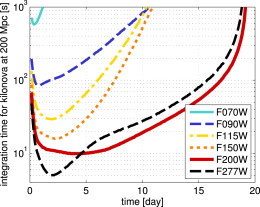Bitten by the gravitational-wave bug? While we await Thursday’s press conference, here’s some food for thought: if LIGO were able to detect gravitational waves from compact-object mergers, how could we follow up on the detections? A new study investigates whether the upcoming James Webb Space Telescope (JWST) will be able to observe electromagnetic signatures of some compact-object mergers.
Hunting for Mergers
Studying compact-object mergers (mergers of black holes and neutron stars) can help us understand a wealth of subjects, like high-energy physics, how matter behaves at nuclear densities, how stars evolve, and how heavy elements in the universe were created.
The Laser Interferometer Gravitational-Wave Observatory (LIGO) is searching for the signature ripples in spacetime identifying these mergers, but gravitational waves are squirrelly: LIGO will only be able to localize wave sources to tens of square degrees. If we want to find out more about any mergers LIGO discovers in gravitational waves, we’ll need a follow-up search for electromagnetic counterparts with other observatories.
The Kilonova Key
One possible electromagnetic counterpart is kilonovae, explosions that can be produced during a merger of a binary neutron star or a neutron star–black hole system. If the neutron star is disrupted during the merger, some of the hot mass is flung outward and shines brightly by radioactive decay.
Kilonovae are especially promising as electromagnetic counterparts to gravitational waves for three reasons:
- They emit isotropically, so the number of observable mergers isn’t limited by relativistic beaming.
- They shine for a week, giving follow-up observatories time to search for them.
- The source location can be easily recovered.
The only problem? We don’t currently have any sensitive survey instruments in the near-infrared band (where kilonova emission peaks) that can provide coverage over tens of square degrees. Luckily, we will soon have just the thing: JWST, launching in 2018!
JWST’s Search

Integration time needed for JWST’s NIRCam to detect a kilonova at 200 Mpc, as a function of time since the merger. Different curves correspond to different NIRCam filters. Note that the total time for follow-up is overwhelmingly dominated by things like telescope slew time, rather than by this exposure time. [Bartos et al. 2016]
Bartos and collaborators calculate that, given the sensitivity of the different filters on JWST’s Near-Infrared Camera, the instrument should easily be able to detect a kilonova 200 Mpc away (a typical distance at which LIGO might be able to find a neutron-star binary). But there’s a catch: 10 deg2 is a really big sky area, and it would take JWST an unfeasible amount of time (days!) to fully cover it.
The authors suggest instead using a targeted search. Since most mergers are expected to be in or near galaxies, JWST could specifically focus the follow-up search on known galaxies within the search area. This approach would bring the total search time down to 12.6 hours, which is within the realm of feasibility. And this time could be reduced even further by concentrating on galaxies most likely to host kilonovae, like those with high star-formation rates.
The conclusion: if LIGO is able to detect gravitational waves, JWST will provide an excellent means to follow up on the detection in the attempt to identify the source.
Citation
I. Bartos et al 2016 ApJ 816 61. doi:10.3847/0004-637X/816/2/61


2 Comments
Pingback: how JWST can follow up on gravitational wave detections
Pingback: Allgemeines Live-Blog vom 18.-26. Februar 2016 | Skyweek Zwei Punkt Null